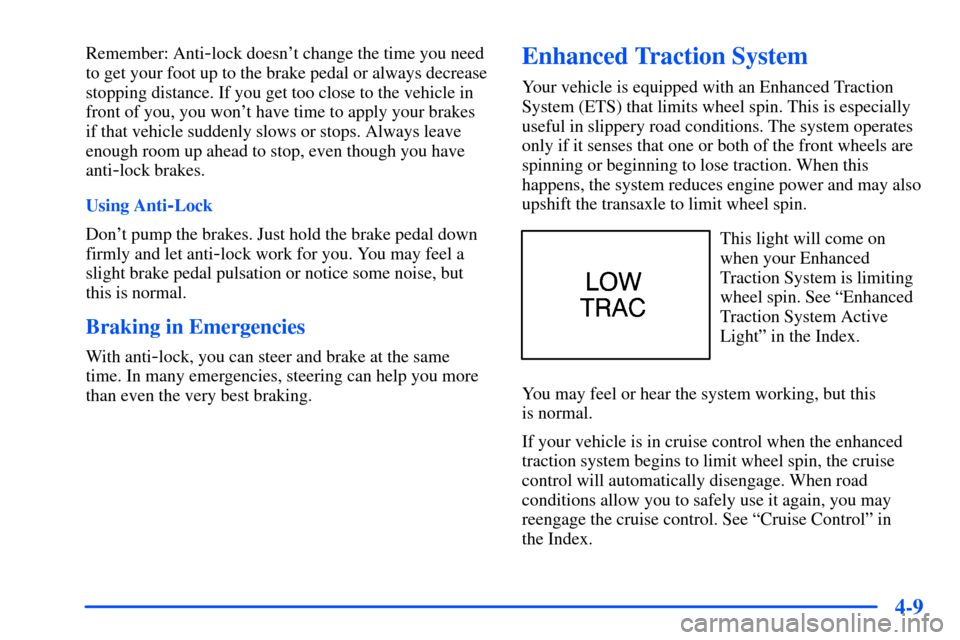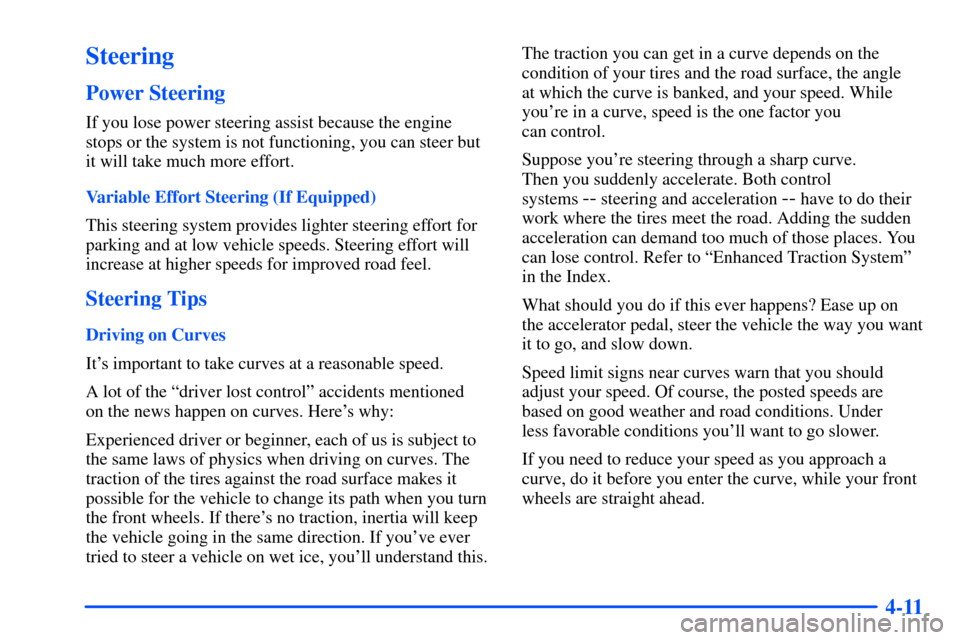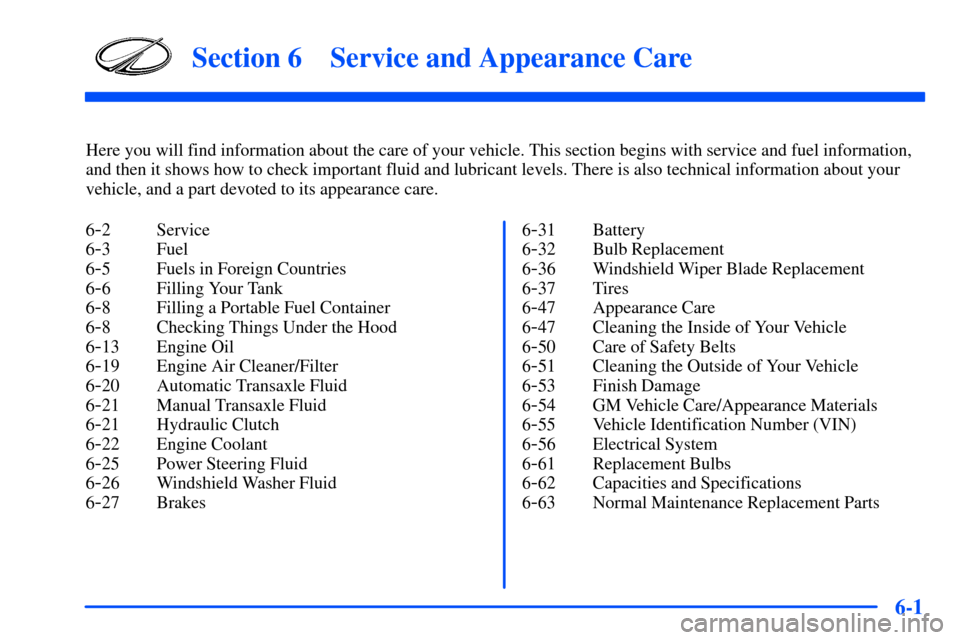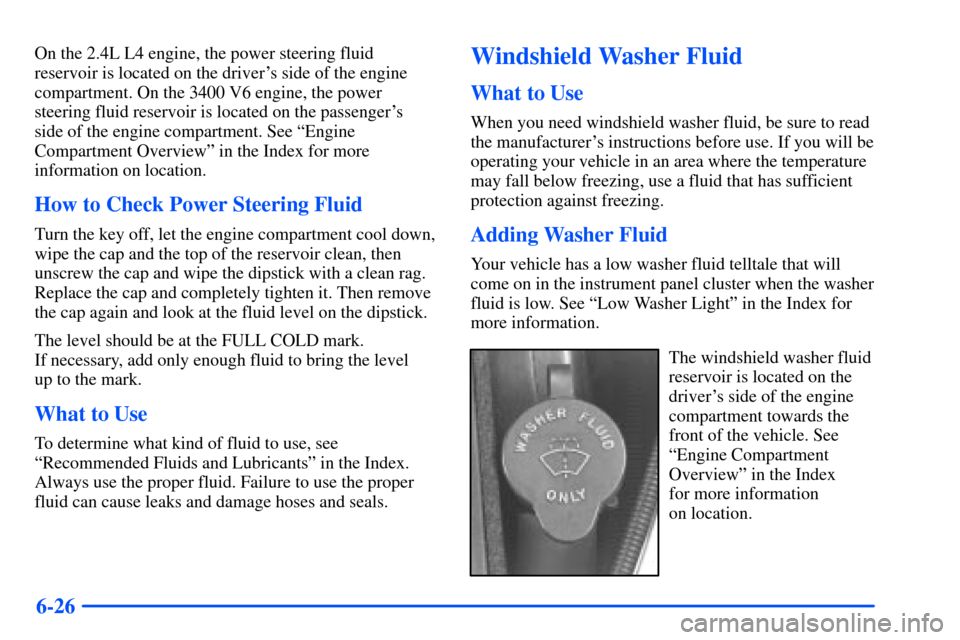Page 176 of 340

4-9
Remember: Anti-lock doesn't change the time you need
to get your foot up to the brake pedal or always decrease
stopping distance. If you get too close to the vehicle in
front of you, you won't have time to apply your brakes
if that vehicle suddenly slows or stops. Always leave
enough room up ahead to stop, even though you have
anti
-lock brakes.
Using Anti
-Lock
Don't pump the brakes. Just hold the brake pedal down
firmly and let anti
-lock work for you. You may feel a
slight brake pedal pulsation or notice some noise, but
this is normal.
Braking in Emergencies
With anti-lock, you can steer and brake at the same
time. In many emergencies, steering can help you more
than even the very best braking.
Enhanced Traction System
Your vehicle is equipped with an Enhanced Traction
System (ETS) that limits wheel spin. This is especially
useful in slippery road conditions. The system operates
only if it senses that one or both of the front wheels are
spinning or beginning to lose traction. When this
happens, the system reduces engine power and may also
upshift the transaxle to limit wheel spin.
This light will come on
when your Enhanced
Traction System is limiting
wheel spin. See ªEnhanced
Traction System Active
Lightº in the Index.
You may feel or hear the system working, but this
is normal.
If your vehicle is in cruise control when the enhanced
traction system begins to limit wheel spin, the cruise
control will automatically disengage. When road
conditions allow you to safely use it again, you may
reengage the cruise control. See ªCruise Controlº in
the Index.
Page 178 of 340

4-11
Steering
Power Steering
If you lose power steering assist because the engine
stops or the system is not functioning, you can steer but
it will take much more effort.
Variable Effort Steering (If Equipped)
This steering system provides lighter steering effort for
parking and at low vehicle speeds. Steering effort will
increase at higher speeds for improved road feel.
Steering Tips
Driving on Curves
It's important to take curves at a reasonable speed.
A lot of the ªdriver lost controlº accidents mentioned
on the news happen on curves. Here's why:
Experienced driver or beginner, each of us is subject to
the same laws of physics when driving on curves. The
traction of the tires against the road surface makes it
possible for the vehicle to change its path when you turn
the front wheels. If there's no traction, inertia will keep
the vehicle going in the same direction. If you've ever
tried to steer a vehicle on wet ice, you'll understand this.The traction you can get in a curve depends on the
condition of your tires and the road surface, the angle
at which the curve is banked, and your speed. While
you're in a curve, speed is the one factor you
can control.
Suppose you're steering through a sharp curve.
Then you suddenly accelerate. Both control
systems
-- steering and acceleration -- have to do their
work where the tires meet the road. Adding the sudden
acceleration can demand too much of those places. You
can lose control. Refer to ªEnhanced Traction Systemº
in the Index.
What should you do if this ever happens? Ease up on
the accelerator pedal, steer the vehicle the way you want
it to go, and slow down.
Speed limit signs near curves warn that you should
adjust your speed. Of course, the posted speeds are
based on good weather and road conditions. Under
less favorable conditions you'll want to go slower.
If you need to reduce your speed as you approach a
curve, do it before you enter the curve, while your front
wheels are straight ahead.
Page 239 of 340

6-
6-1
Section 6 Service and Appearance Care
Here you will find information about the care of your vehicle. This section begins with service and fuel information,
and then it shows how to check important fluid and lubricant levels. There is also technical information about your
vehicle, and a part devoted to its appearance care.
6
-2 Service
6
-3 Fuel
6
-5 Fuels in Foreign Countries
6
-6 Filling Your Tank
6
-8 Filling a Portable Fuel Container
6
-8 Checking Things Under the Hood
6
-13 Engine Oil
6
-19 Engine Air Cleaner/Filter
6
-20 Automatic Transaxle Fluid
6
-21 Manual Transaxle Fluid
6
-21 Hydraulic Clutch
6
-22 Engine Coolant
6
-25 Power Steering Fluid
6
-26 Windshield Washer Fluid
6
-27 Brakes6
-31 Battery
6
-32 Bulb Replacement
6
-36 Windshield Wiper Blade Replacement
6
-37 Tires
6
-47 Appearance Care
6
-47 Cleaning the Inside of Your Vehicle
6
-50 Care of Safety Belts
6
-51 Cleaning the Outside of Your Vehicle
6
-53 Finish Damage
6
-54 GM Vehicle Care/Appearance Materials
6
-55 Vehicle Identification Number (VIN)
6
-56 Electrical System
6
-61 Replacement Bulbs
6
-62 Capacities and Specifications
6
-63 Normal Maintenance Replacement Parts
Page 249 of 340
6-11 Engine Compartment Overview
When you open the hood on the 2.4L L4 engine, you'll see the following:
A. Engine Coolant Surge Tank
B. Engine Oil Fill Cap
C. Engine Oil DipstickD. Power Steering Fluid Reservoir
E. Brake Fluid Reservoir
F. Engine Air Cleaner/FilterG. Battery
H. Windshield Washer
Fluid Reservoir
Page 250 of 340
6-12
When you open the hood on the 3400 V6 engine, you'll see the following:
A. Engine Coolant Surge Tank
B. Power Steering Fluid Reservoir
C. Engine Oil Fill CapD. Engine Oil Dipstick
E. Brake Fluid Reservoir
F. Engine Air Cleaner/FilterG. Battery
H. Windshield Washer
Fluid Reservoir
Page 263 of 340
6-25
Adding Coolant
If you need more coolant, add the proper DEX
-COOL�
coolant mixture at the surge tank, but only when the
engine is cool.
CAUTION:
You can be burned if you spill coolant on hot
engine parts. Coolant contains ethylene glycol,
and it will burn if the engine parts are hot
enough. Don't spill coolant on a hot engine.
When replacing the pressure cap, make sure it
is hand
-tight.
Power Steering Fluid
When to Check Power Steering Fluid
It is not necessary to regularly check power steering
fluid unless you suspect there is a leak in the system or
you hear an unusual noise. A fluid loss in this system
could indicate a problem. Have the system inspected
and repaired.
Page 264 of 340

6-26
On the 2.4L L4 engine, the power steering fluid
reservoir is located on the driver's side of the engine
compartment. On the 3400 V6 engine, the power
steering fluid reservoir is located on the passenger's
side of the engine compartment. See ªEngine
Compartment Overviewº in the Index for more
information on location.
How to Check Power Steering Fluid
Turn the key off, let the engine compartment cool down,
wipe the cap and the top of the reservoir clean, then
unscrew the cap and wipe the dipstick with a clean rag.
Replace the cap and completely tighten it. Then remove
the cap again and look at the fluid level on the dipstick.
The level should be at the FULL COLD mark.
If necessary, add only enough fluid to bring the level
up to the mark.
What to Use
To determine what kind of fluid to use, see
ªRecommended Fluids and Lubricantsº in the Index.
Always use the proper fluid. Failure to use the proper
fluid can cause leaks and damage hoses and seals.
Windshield Washer Fluid
What to Use
When you need windshield washer fluid, be sure to read
the manufacturer's instructions before use. If you will be
operating your vehicle in an area where the temperature
may fall below freezing, use a fluid that has sufficient
protection against freezing.
Adding Washer Fluid
Your vehicle has a low washer fluid telltale that will
come on in the instrument panel cluster when the washer
fluid is low. See ªLow Washer Lightº in the Index for
more information.
The windshield washer fluid
reservoir is located on the
driver's side of the engine
compartment towards the
front of the vehicle. See
ªEngine Compartment
Overviewº in the Index
for more information
on location.
Page 296 of 340
6-58
Instrument Panel Fuse Block -- Passenger's Side
Fuse Usage
INST LPS Interior Lamp Dimming
CRUISE
SW LPSSteering Wheel Cruise Control
Switch Lamps Fuse Usage
CRUISE SW Steering Wheel Cruise
Control Switches
HVAC
BLOWERHVAC Blower Motor
CRUISE Cruise Control
FOG LPS Fog Lamps
INT LPS Interior Courtesy Lamps
RADIO BATT Radio
SUNROOF Power Sunroof
Circuit Breaker Usage
PWR WNDW Power Windows
Relay Usage
FOG LPS Fog Lamps